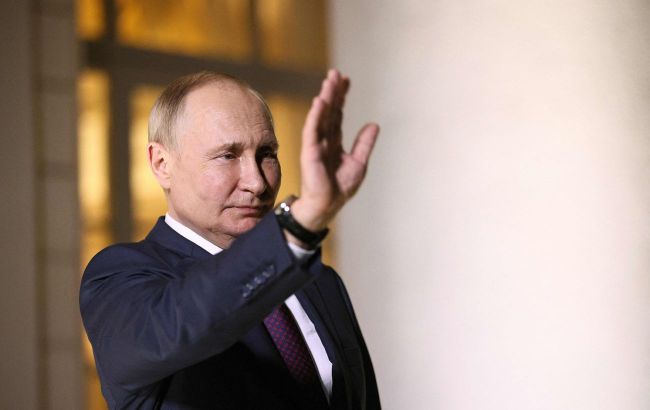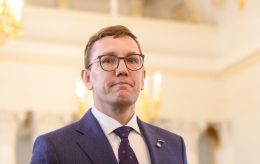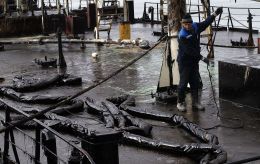Putin already in Alaska? What is known about flight to summit with Trump
 Photo: Russian President Vladimir Putin (Getty Images)
Photo: Russian President Vladimir Putin (Getty Images)
Russian President Vladimir Putin is expected to arrive in Anchorage, Alaska, for a meeting with US President Donald Trump. The main topic of their discussions will be the war in Ukraine.
What is known about Putin’s arrival in Alaska – in the RBC-Ukraine report below.
As of 08:55 PM Kyiv time, several Western media outlets monitoring the flight of Russia’s Air Force One via Flightradar24 and streaming from the airfield reported that the plane carrying the Russian leader had landed in Anchorage.
Footage of the aircraft’s landing was also shown.
However, a few minutes later, a Kremlin pool representative, propagandist Pavel Zarubin, reported that it was not Putin’s plane but another advanced aircraft of Russia’s Special Flight Detachment, and Putin’s arrival is still awaited.
It is worth noting that on the way to Alaska, the Russian President visited Magadan, where he held working meetings and toured a fish factory.
Updated 09:55 PM Kyiv time
Russian state media reported that Putin has arrived in Alaska.
Where and when Putin will meet with Trump
Putin is visiting the US for the first time in a decade – his previous trip was to New York for the UN General Assembly in 2015.
The meeting between the Russian dictator and the US president is scheduled for 11:00 AM local time (10:00 PM Kyiv time) at the US military base Elmendorf-Richardson in Anchorage, according to the White House. The Kremlin has announced a different time – 11:30 AM (10:30 PM Kyiv time).
First, Putin and Trump will make brief remarks and hold a one-on-one conversation. After that, they will meet in a delegation format over a working breakfast.
Trump’s delegation includes:
-
US Secretary of State Marco Rubio
-
Treasury Secretary Scott Bessent
-
Commerce Secretary Howard Lutnick
-
Director of National Intelligence John Ratcliffe
-
White House Chief of Staff Susie Wiles
-
White House Political Director James Blair
-
White House Deputy Chief of Staff Beau Harrison
-
Communications Director Nick Luna
-
Deputy Communications Director Dan Scavino
-
White House Press Secretary Steven Cheung
-
National Security Advisor Robert Gabriel
-
White House Press Secretary Karoline Leavitt
-
Legal Counsel Will Scharf
-
Economic Policy Advisor Ross Worthington
-
Special Envoy Steve Witkoff
-
US Ambassador Monica Crowley.
Representing the Russian side, in addition to Putin:
-
Russian Foreign Minister Sergey Lavrov
-
Russian Defense Minister Andrey Belousov
-
Russian Finance Minister Anton Siluanov
-
Head of the Russian Direct Investment Fund (RFPI) Kirill Dmitriev
-
Kremlin aide Yuri Ushakov.
Following the talks, the US and Russian leaders will hold a joint press conference.
Topic of the talks – Ukraine
The meeting in Alaska was agreed upon against the backdrop of an approaching deadline set by Trump for Putin to agree to a peace deal on Ukraine. According to Washington, Moscow requested this meeting when US Special Envoy Steve Witkoff visited the Kremlin last week.
The central topic of the summit will be the war in Ukraine. The White House chief spoke with European leaders and President Volodymyr Zelenskyy before his meeting with the Russian President and promised to do so again after the talks with Putin. However, he later said he would not make any calls if the summit produced no results.
Trump stressed to his allies that the main goal of the talks with Putin is to achieve a ceasefire in Ukraine. He expressed hope that the dictator "will want to reach a deal." For its part, the Kremlin said that "no document is planned following the summit."
The White House chief described the Alaska summit as "a dispute over borders and lands." However, he assured European leaders that during the meeting with Putin, he would not negotiate over Ukrainian territories and would press the Russian leader to meet with Zelenskyy.
Territorial issue
The Wall Street Journal reported that Putin had presented the Trump administration with a plan for a ceasefire in exchange for territorial concessions from Ukraine.
One version outlined in the media is as follows: Moscow wants Ukraine to hand over its entire eastern part of Donbas (currently controlled by the Ukrainian Armed Forces) as well as Crimea. In return, the Russian forces would reportedly halt their offensive in the Kherson and Zaporizhzhia regions. Kyiv, however, rejects this.
Zelenskyy stressed that "the answer to Ukraine’s territorial question is already in the Constitution of Ukraine, and no one will back down from this, nor will they be able to."
European allies also emphasize that decisions regarding a "possible exchange of territories" and other peace conditions must be agreed upon with Ukraine’s participation.
The US leader, for his part, underlined that talks on territorial matters would take place only with Zelenskyy present during a future meeting (Western media reports that a venue for a Trump-Zelenskyy-Putin summit is being sought).
The Ukrainian president, in turn, highlights that any territorial issue cannot be separated from security guarantees. According to Politico, Trump is ready to provide such guarantees to Ukraine if a ceasefire is reached, but on the condition that these efforts are not carried out within NATO.
Zelenskyy has also emphasized that Russia is not demonstrating a genuine willingness to achieve peace and, on the contrary, is preparing new offensive operations.
What to expect next
The White House explains that the US needs this summit with Putin to determine whether peace in Ukraine is truly possible. According to Trump’s plan, if the meeting in Alaska with Putin is successful, the next summit would include President Zelenskyy.
The Ukrainian leader himself, sources told RBC-Ukraine, is ready to meet the Russian President in any format, whereas Putin is "not very" willing.
The Ukrainian president said that following a videoconference with Trump and European leaders this Wednesday, five key principles were agreed upon – ranging from security guarantees to the strengthening of sanctions if Moscow refuses to implement a ceasefire.
Washington, meanwhile, remains cautious in its rhetoric. The White House states that Trump does not want to impose sanctions on Russia, and that his "priority is diplomacy."
However, the US leader once again warned that the consequences for Moscow would be "very serious" if it does not agree to a truce. At the same time, US Treasury Secretary Scott Bessent said that during the meeting with Putin, Trump plans to use the issue of sanctions against Russia as a means of pressure.
For an in-depth analysis of what preceded the US-Russia summit in Alaska, what it means for Ukraine, and what to expect, see the separate RBC-Ukraine report.

